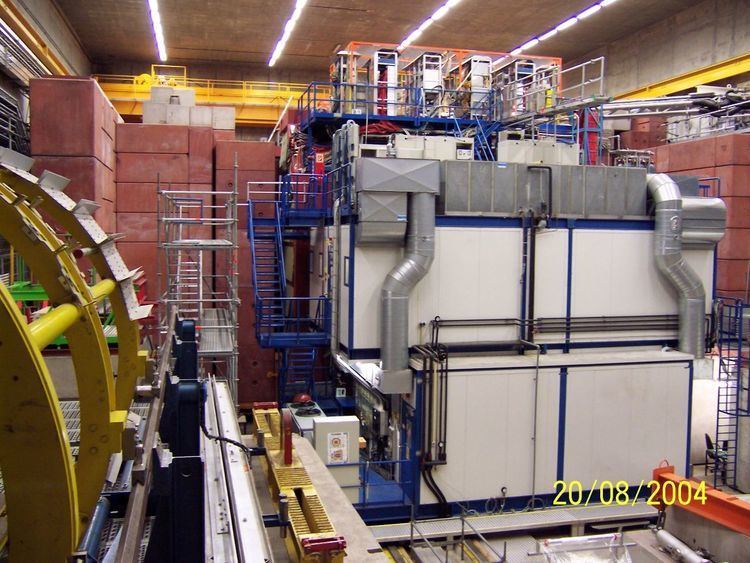 | ||
H1 was a particle detector that operated at HERA (Hadron Elektron Ring Anlage) in DESY, Hamburg. The first studies for the H1 experiment have proposed in 1981 and the H1 detector began operating together with HERA in 1992 and took data until 2007. The detector consisted of several different detector components and was about 12 x 15 x 10 meters big and weighs 2800 tons. It was accompanied by further detectors in both directions of the HERA accelerator and by an electronics trailer three stories high.
Contents
The main physics goals of the H1 experiment were the investigation of the internal structure of the proton through measurements of deep inelastic scattering, the measurements of further cross sections to study fundamental interactions between particles in order to test the Standard Model of particle physics, as well as searching for particles beyond the Standard Model.
The name H1 is used for both, the detector itself and the collaboration of physicists and technicians who operated the experiment.
History
The construction of an lepton-proton collider was recommended strongly by ECFA on May 9, 1980 [1][2]. The first proposals for the H1 detector have been made in 1981 and the letter of intent for the H1 experiment was published on June 28, 1985 [3]. The technical proposal for the H1 detector was finalized on March 25, 1986 [4].
The H1 detector was operational with the first collisions of HERA in 1992. It was upgraded during the HERA luminosity upgrade for the HERA-II running period from 2000 to 2003. The H1 detector then took data until the shutdown of HERA in June 2007 and was mostly dismantled afterwards.
Several subdetector components are now exhibited in the HERA Hall West at DESY. The HERA North Hall, where the H1 detector was located, is now used for other particle physics and gravitational experiments by DESY.
The data taken with the H1 detector are preserved for future analyses within the DPHEP (Data Preservation and Long Term Analysis in High Energy Physics) initiative [5].
The "sister experiment" of H1 at the HERA accelerator is the ZEUS experiment, which is also a multi-purpose detector with similar physics goals as H1.
The H1 Collaboration
The H1 experiment was designed and operated by an international collaboration of about 400 physicists and technicians from 43 institutes in 18 countries (List of currently participating institutes).
The H1 Detector
Leptons (electrons or positrons) are collided with protons by HERA in the interaction point of H1 and the particles produced in these collisions were detected by the H1 detector components. The reaction products, often including the proton remnant and the scattered lepton, are detected by several subdetectors. Combination of their information allows the identification of particles from the reaction, or at least the reconstruction of the overall reaction kinematics. This in turn allows the classification of the reaction. From the center outwards, H1's most important systems are:
In addition to these systems, H1 has several helper systems, such as a luminosity system, ToF (time of flight) detectors and radiation monitors. Also in the course of time additional detector systems have been added as the focus on special physics processes has become bigger. For example, forward instrumentation for diffractive physics has been added far down the HERA tunnel.
While H1 is a general purpose detector its main design feature is an asymmetric construction to cope with the boosted center of mass in the laboratory frame due to the large energy imbalance of the colliding beams. In the forward (incident proton) direction the instrumentation has higher granularity to give a better resolution for refined measurement of the proton remnant left after the collision with the incident lepton. In the backward direction, where the leption is mostly scattered into the detectors were optimized for the reconstruction of the scattered lepton trajectory.
Physics addressed by H1
The most interesting physics topics treated at H1 include
